Indigenous Australian Histories and Cultures: Contemporary Realities
VerifiedAdded on 2022/12/29
|8
|1889
|96
AI Summary
This report explores the knowledge of Indigenous Australian people and their diverse realities. It discusses the impact of pre-1967 policies, the 1967 referendum, indigenous health, and human rights in Australia.
Contribute Materials
Your contribution can guide someone’s learning journey. Share your
documents today.
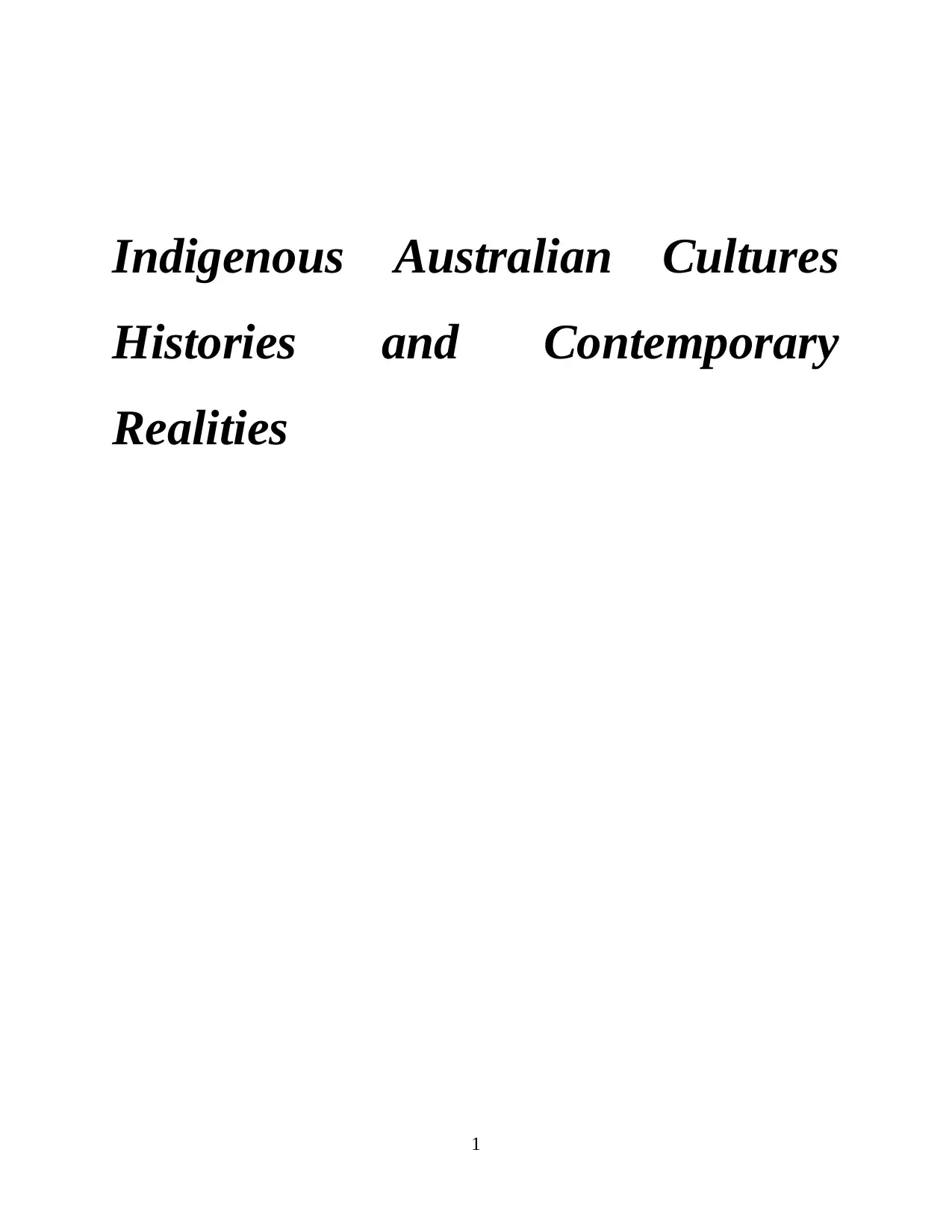
Indigenous Australian Cultures
Histories and Contemporary
Realities
1
Histories and Contemporary
Realities
1
Secure Best Marks with AI Grader
Need help grading? Try our AI Grader for instant feedback on your assignments.
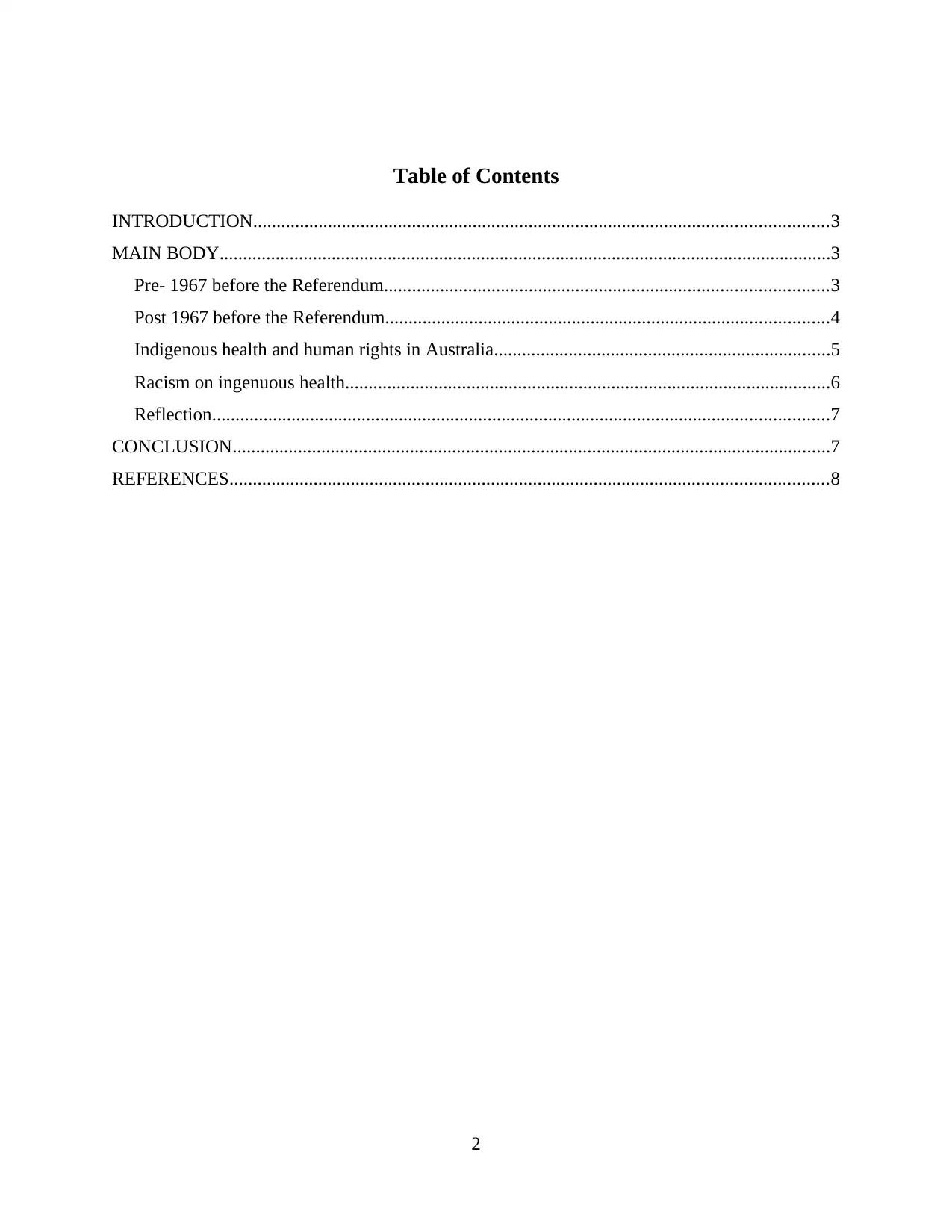
Table of Contents
INTRODUCTION...........................................................................................................................3
MAIN BODY...................................................................................................................................3
Pre- 1967 before the Referendum...............................................................................................3
Post 1967 before the Referendum...............................................................................................4
Indigenous health and human rights in Australia........................................................................5
Racism on ingenuous health........................................................................................................6
Reflection....................................................................................................................................7
CONCLUSION................................................................................................................................7
REFERENCES................................................................................................................................8
2
INTRODUCTION...........................................................................................................................3
MAIN BODY...................................................................................................................................3
Pre- 1967 before the Referendum...............................................................................................3
Post 1967 before the Referendum...............................................................................................4
Indigenous health and human rights in Australia........................................................................5
Racism on ingenuous health........................................................................................................6
Reflection....................................................................................................................................7
CONCLUSION................................................................................................................................7
REFERENCES................................................................................................................................8
2
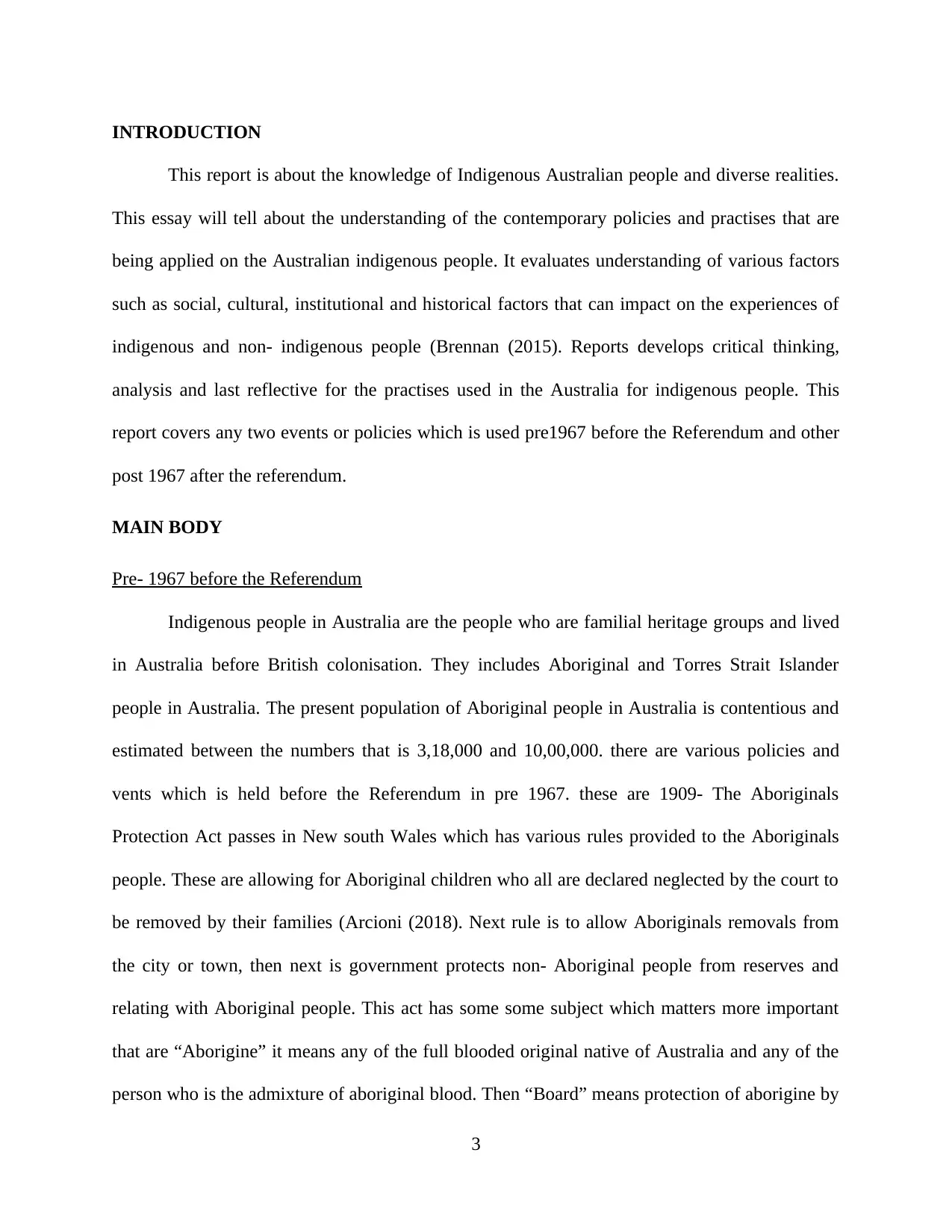
INTRODUCTION
This report is about the knowledge of Indigenous Australian people and diverse realities.
This essay will tell about the understanding of the contemporary policies and practises that are
being applied on the Australian indigenous people. It evaluates understanding of various factors
such as social, cultural, institutional and historical factors that can impact on the experiences of
indigenous and non- indigenous people (Brennan (2015). Reports develops critical thinking,
analysis and last reflective for the practises used in the Australia for indigenous people. This
report covers any two events or policies which is used pre1967 before the Referendum and other
post 1967 after the referendum.
MAIN BODY
Pre- 1967 before the Referendum
Indigenous people in Australia are the people who are familial heritage groups and lived
in Australia before British colonisation. They includes Aboriginal and Torres Strait Islander
people in Australia. The present population of Aboriginal people in Australia is contentious and
estimated between the numbers that is 3,18,000 and 10,00,000. there are various policies and
vents which is held before the Referendum in pre 1967. these are 1909- The Aboriginals
Protection Act passes in New south Wales which has various rules provided to the Aboriginals
people. These are allowing for Aboriginal children who all are declared neglected by the court to
be removed by their families (Arcioni (2018). Next rule is to allow Aboriginals removals from
the city or town, then next is government protects non- Aboriginal people from reserves and
relating with Aboriginal people. This act has some some subject which matters more important
that are “Aborigine” it means any of the full blooded original native of Australia and any of the
person who is the admixture of aboriginal blood. Then “Board” means protection of aborigine by
3
This report is about the knowledge of Indigenous Australian people and diverse realities.
This essay will tell about the understanding of the contemporary policies and practises that are
being applied on the Australian indigenous people. It evaluates understanding of various factors
such as social, cultural, institutional and historical factors that can impact on the experiences of
indigenous and non- indigenous people (Brennan (2015). Reports develops critical thinking,
analysis and last reflective for the practises used in the Australia for indigenous people. This
report covers any two events or policies which is used pre1967 before the Referendum and other
post 1967 after the referendum.
MAIN BODY
Pre- 1967 before the Referendum
Indigenous people in Australia are the people who are familial heritage groups and lived
in Australia before British colonisation. They includes Aboriginal and Torres Strait Islander
people in Australia. The present population of Aboriginal people in Australia is contentious and
estimated between the numbers that is 3,18,000 and 10,00,000. there are various policies and
vents which is held before the Referendum in pre 1967. these are 1909- The Aboriginals
Protection Act passes in New south Wales which has various rules provided to the Aboriginals
people. These are allowing for Aboriginal children who all are declared neglected by the court to
be removed by their families (Arcioni (2018). Next rule is to allow Aboriginals removals from
the city or town, then next is government protects non- Aboriginal people from reserves and
relating with Aboriginal people. This act has some some subject which matters more important
that are “Aborigine” it means any of the full blooded original native of Australia and any of the
person who is the admixture of aboriginal blood. Then “Board” means protection of aborigine by
3
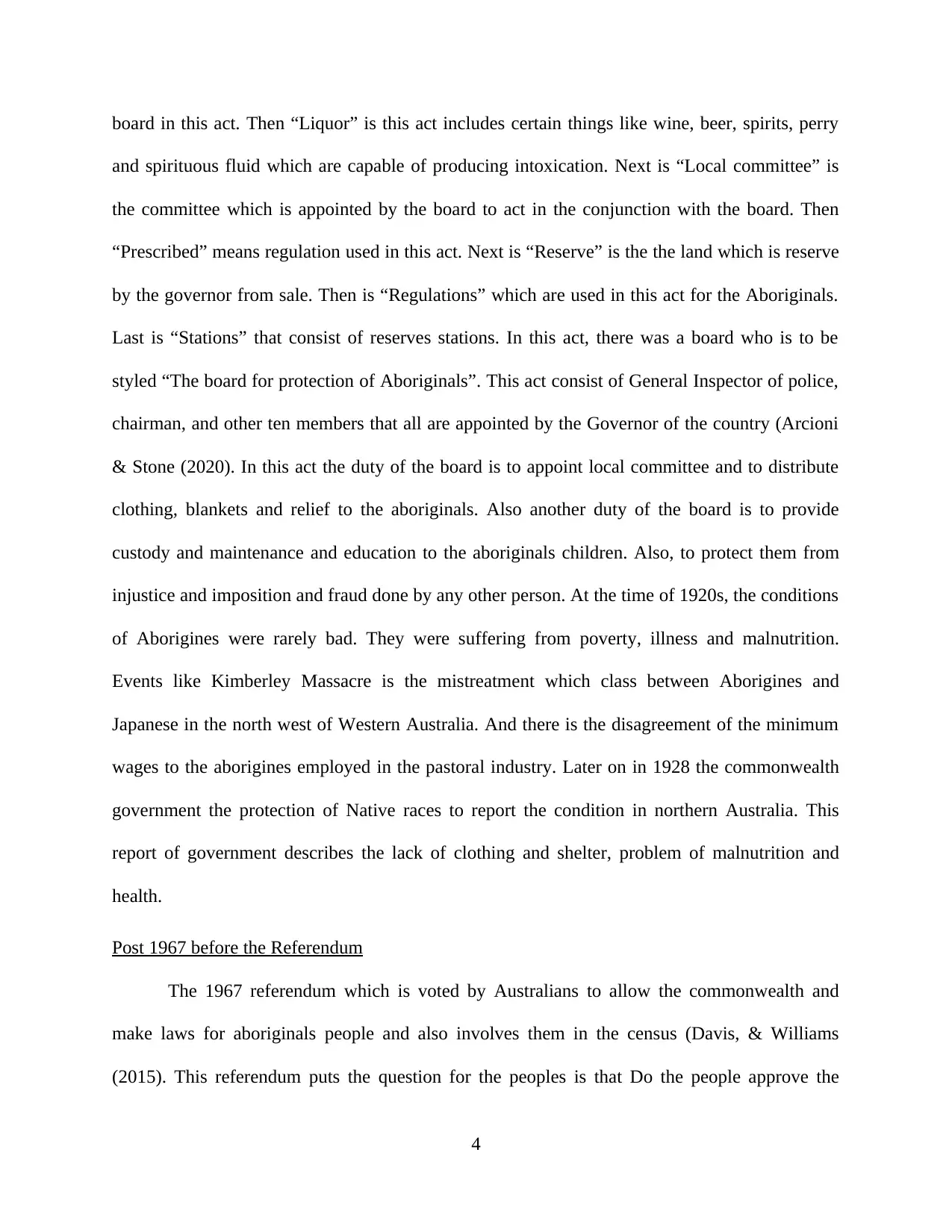
board in this act. Then “Liquor” is this act includes certain things like wine, beer, spirits, perry
and spirituous fluid which are capable of producing intoxication. Next is “Local committee” is
the committee which is appointed by the board to act in the conjunction with the board. Then
“Prescribed” means regulation used in this act. Next is “Reserve” is the the land which is reserve
by the governor from sale. Then is “Regulations” which are used in this act for the Aboriginals.
Last is “Stations” that consist of reserves stations. In this act, there was a board who is to be
styled “The board for protection of Aboriginals”. This act consist of General Inspector of police,
chairman, and other ten members that all are appointed by the Governor of the country (Arcioni
& Stone (2020). In this act the duty of the board is to appoint local committee and to distribute
clothing, blankets and relief to the aboriginals. Also another duty of the board is to provide
custody and maintenance and education to the aboriginals children. Also, to protect them from
injustice and imposition and fraud done by any other person. At the time of 1920s, the conditions
of Aborigines were rarely bad. They were suffering from poverty, illness and malnutrition.
Events like Kimberley Massacre is the mistreatment which class between Aborigines and
Japanese in the north west of Western Australia. And there is the disagreement of the minimum
wages to the aborigines employed in the pastoral industry. Later on in 1928 the commonwealth
government the protection of Native races to report the condition in northern Australia. This
report of government describes the lack of clothing and shelter, problem of malnutrition and
health.
Post 1967 before the Referendum
The 1967 referendum which is voted by Australians to allow the commonwealth and
make laws for aboriginals people and also involves them in the census (Davis, & Williams
(2015). This referendum puts the question for the peoples is that Do the people approve the
4
and spirituous fluid which are capable of producing intoxication. Next is “Local committee” is
the committee which is appointed by the board to act in the conjunction with the board. Then
“Prescribed” means regulation used in this act. Next is “Reserve” is the the land which is reserve
by the governor from sale. Then is “Regulations” which are used in this act for the Aboriginals.
Last is “Stations” that consist of reserves stations. In this act, there was a board who is to be
styled “The board for protection of Aboriginals”. This act consist of General Inspector of police,
chairman, and other ten members that all are appointed by the Governor of the country (Arcioni
& Stone (2020). In this act the duty of the board is to appoint local committee and to distribute
clothing, blankets and relief to the aboriginals. Also another duty of the board is to provide
custody and maintenance and education to the aboriginals children. Also, to protect them from
injustice and imposition and fraud done by any other person. At the time of 1920s, the conditions
of Aborigines were rarely bad. They were suffering from poverty, illness and malnutrition.
Events like Kimberley Massacre is the mistreatment which class between Aborigines and
Japanese in the north west of Western Australia. And there is the disagreement of the minimum
wages to the aborigines employed in the pastoral industry. Later on in 1928 the commonwealth
government the protection of Native races to report the condition in northern Australia. This
report of government describes the lack of clothing and shelter, problem of malnutrition and
health.
Post 1967 before the Referendum
The 1967 referendum which is voted by Australians to allow the commonwealth and
make laws for aboriginals people and also involves them in the census (Davis, & Williams
(2015). This referendum puts the question for the peoples is that Do the people approve the
4
Secure Best Marks with AI Grader
Need help grading? Try our AI Grader for instant feedback on your assignments.
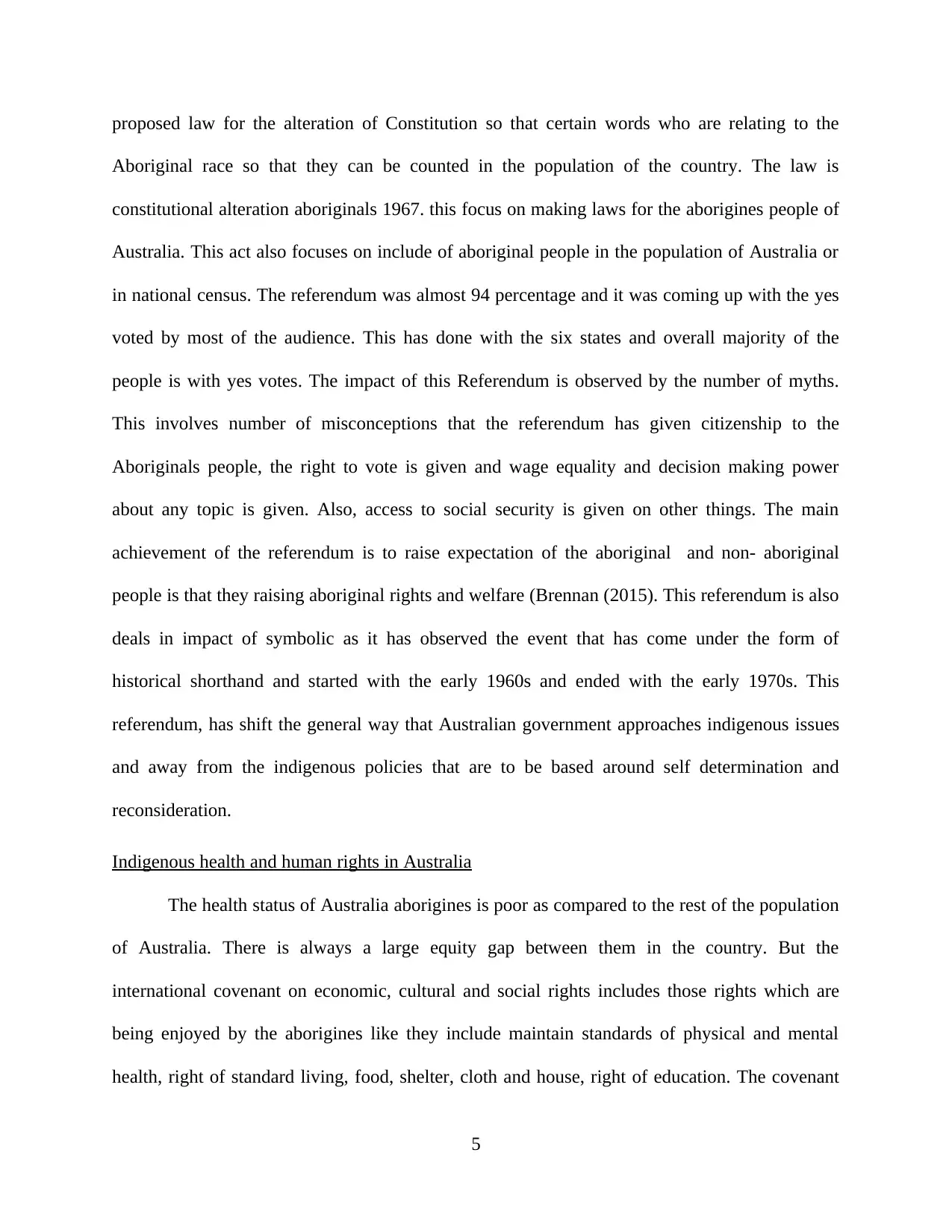
proposed law for the alteration of Constitution so that certain words who are relating to the
Aboriginal race so that they can be counted in the population of the country. The law is
constitutional alteration aboriginals 1967. this focus on making laws for the aborigines people of
Australia. This act also focuses on include of aboriginal people in the population of Australia or
in national census. The referendum was almost 94 percentage and it was coming up with the yes
voted by most of the audience. This has done with the six states and overall majority of the
people is with yes votes. The impact of this Referendum is observed by the number of myths.
This involves number of misconceptions that the referendum has given citizenship to the
Aboriginals people, the right to vote is given and wage equality and decision making power
about any topic is given. Also, access to social security is given on other things. The main
achievement of the referendum is to raise expectation of the aboriginal and non- aboriginal
people is that they raising aboriginal rights and welfare (Brennan (2015). This referendum is also
deals in impact of symbolic as it has observed the event that has come under the form of
historical shorthand and started with the early 1960s and ended with the early 1970s. This
referendum, has shift the general way that Australian government approaches indigenous issues
and away from the indigenous policies that are to be based around self determination and
reconsideration.
Indigenous health and human rights in Australia
The health status of Australia aborigines is poor as compared to the rest of the population
of Australia. There is always a large equity gap between them in the country. But the
international covenant on economic, cultural and social rights includes those rights which are
being enjoyed by the aborigines like they include maintain standards of physical and mental
health, right of standard living, food, shelter, cloth and house, right of education. The covenant
5
Aboriginal race so that they can be counted in the population of the country. The law is
constitutional alteration aboriginals 1967. this focus on making laws for the aborigines people of
Australia. This act also focuses on include of aboriginal people in the population of Australia or
in national census. The referendum was almost 94 percentage and it was coming up with the yes
voted by most of the audience. This has done with the six states and overall majority of the
people is with yes votes. The impact of this Referendum is observed by the number of myths.
This involves number of misconceptions that the referendum has given citizenship to the
Aboriginals people, the right to vote is given and wage equality and decision making power
about any topic is given. Also, access to social security is given on other things. The main
achievement of the referendum is to raise expectation of the aboriginal and non- aboriginal
people is that they raising aboriginal rights and welfare (Brennan (2015). This referendum is also
deals in impact of symbolic as it has observed the event that has come under the form of
historical shorthand and started with the early 1960s and ended with the early 1970s. This
referendum, has shift the general way that Australian government approaches indigenous issues
and away from the indigenous policies that are to be based around self determination and
reconsideration.
Indigenous health and human rights in Australia
The health status of Australia aborigines is poor as compared to the rest of the population
of Australia. There is always a large equity gap between them in the country. But the
international covenant on economic, cultural and social rights includes those rights which are
being enjoyed by the aborigines like they include maintain standards of physical and mental
health, right of standard living, food, shelter, cloth and house, right of education. The covenant
5
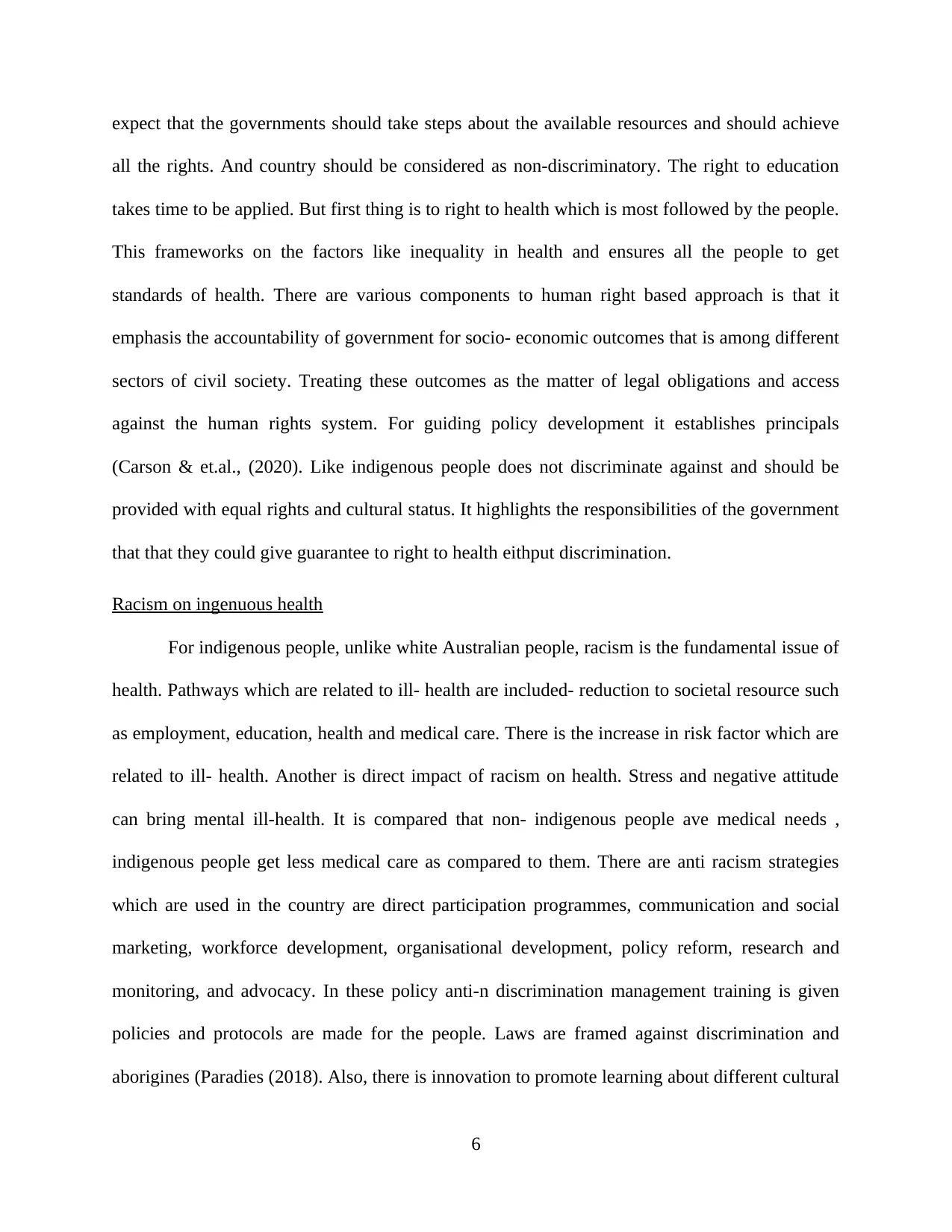
expect that the governments should take steps about the available resources and should achieve
all the rights. And country should be considered as non-discriminatory. The right to education
takes time to be applied. But first thing is to right to health which is most followed by the people.
This frameworks on the factors like inequality in health and ensures all the people to get
standards of health. There are various components to human right based approach is that it
emphasis the accountability of government for socio- economic outcomes that is among different
sectors of civil society. Treating these outcomes as the matter of legal obligations and access
against the human rights system. For guiding policy development it establishes principals
(Carson & et.al., (2020). Like indigenous people does not discriminate against and should be
provided with equal rights and cultural status. It highlights the responsibilities of the government
that that they could give guarantee to right to health eithput discrimination.
Racism on ingenuous health
For indigenous people, unlike white Australian people, racism is the fundamental issue of
health. Pathways which are related to ill- health are included- reduction to societal resource such
as employment, education, health and medical care. There is the increase in risk factor which are
related to ill- health. Another is direct impact of racism on health. Stress and negative attitude
can bring mental ill-health. It is compared that non- indigenous people ave medical needs ,
indigenous people get less medical care as compared to them. There are anti racism strategies
which are used in the country are direct participation programmes, communication and social
marketing, workforce development, organisational development, policy reform, research and
monitoring, and advocacy. In these policy anti-n discrimination management training is given
policies and protocols are made for the people. Laws are framed against discrimination and
aborigines (Paradies (2018). Also, there is innovation to promote learning about different cultural
6
all the rights. And country should be considered as non-discriminatory. The right to education
takes time to be applied. But first thing is to right to health which is most followed by the people.
This frameworks on the factors like inequality in health and ensures all the people to get
standards of health. There are various components to human right based approach is that it
emphasis the accountability of government for socio- economic outcomes that is among different
sectors of civil society. Treating these outcomes as the matter of legal obligations and access
against the human rights system. For guiding policy development it establishes principals
(Carson & et.al., (2020). Like indigenous people does not discriminate against and should be
provided with equal rights and cultural status. It highlights the responsibilities of the government
that that they could give guarantee to right to health eithput discrimination.
Racism on ingenuous health
For indigenous people, unlike white Australian people, racism is the fundamental issue of
health. Pathways which are related to ill- health are included- reduction to societal resource such
as employment, education, health and medical care. There is the increase in risk factor which are
related to ill- health. Another is direct impact of racism on health. Stress and negative attitude
can bring mental ill-health. It is compared that non- indigenous people ave medical needs ,
indigenous people get less medical care as compared to them. There are anti racism strategies
which are used in the country are direct participation programmes, communication and social
marketing, workforce development, organisational development, policy reform, research and
monitoring, and advocacy. In these policy anti-n discrimination management training is given
policies and protocols are made for the people. Laws are framed against discrimination and
aborigines (Paradies (2018). Also, there is innovation to promote learning about different cultural
6
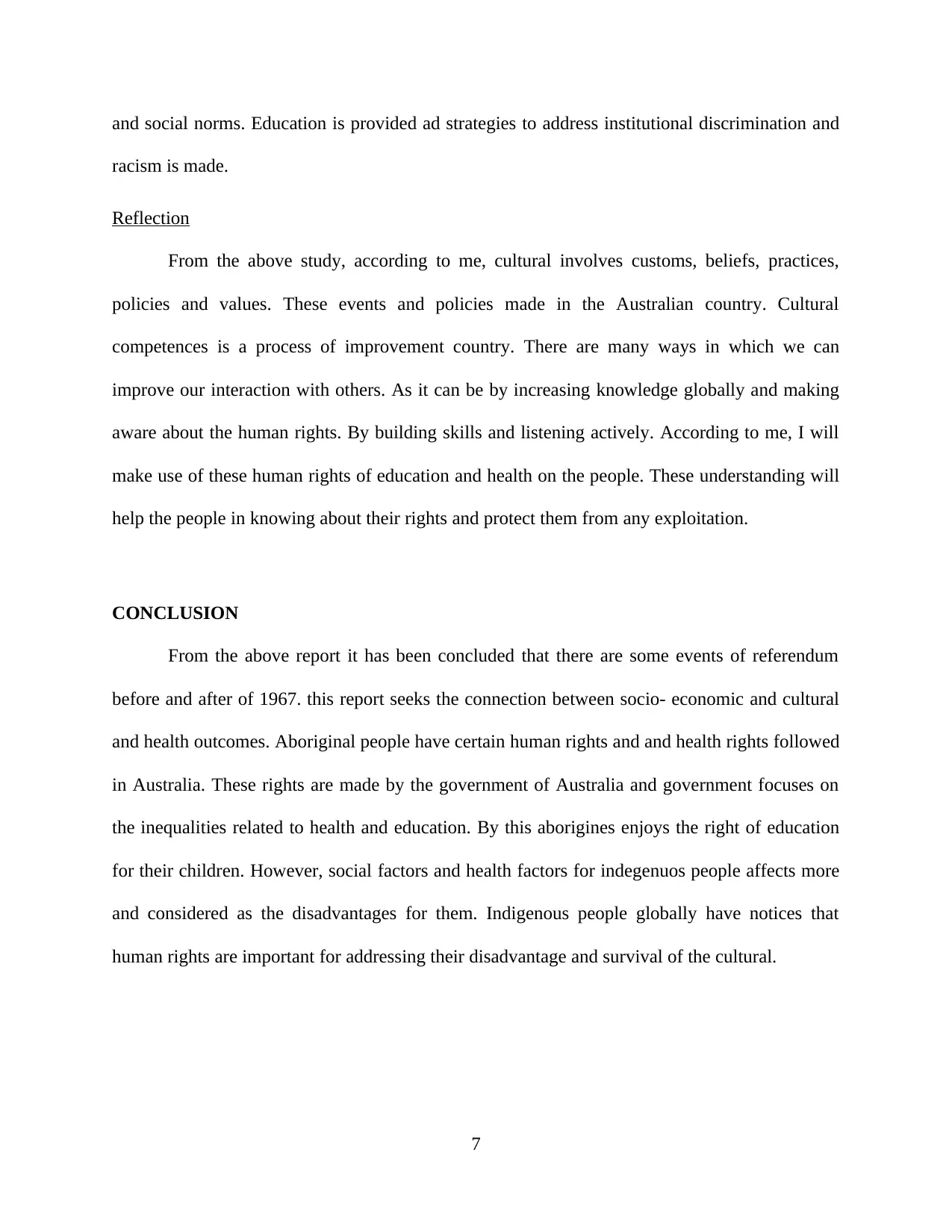
and social norms. Education is provided ad strategies to address institutional discrimination and
racism is made.
Reflection
From the above study, according to me, cultural involves customs, beliefs, practices,
policies and values. These events and policies made in the Australian country. Cultural
competences is a process of improvement country. There are many ways in which we can
improve our interaction with others. As it can be by increasing knowledge globally and making
aware about the human rights. By building skills and listening actively. According to me, I will
make use of these human rights of education and health on the people. These understanding will
help the people in knowing about their rights and protect them from any exploitation.
CONCLUSION
From the above report it has been concluded that there are some events of referendum
before and after of 1967. this report seeks the connection between socio- economic and cultural
and health outcomes. Aboriginal people have certain human rights and and health rights followed
in Australia. These rights are made by the government of Australia and government focuses on
the inequalities related to health and education. By this aborigines enjoys the right of education
for their children. However, social factors and health factors for indegenuos people affects more
and considered as the disadvantages for them. Indigenous people globally have notices that
human rights are important for addressing their disadvantage and survival of the cultural.
7
racism is made.
Reflection
From the above study, according to me, cultural involves customs, beliefs, practices,
policies and values. These events and policies made in the Australian country. Cultural
competences is a process of improvement country. There are many ways in which we can
improve our interaction with others. As it can be by increasing knowledge globally and making
aware about the human rights. By building skills and listening actively. According to me, I will
make use of these human rights of education and health on the people. These understanding will
help the people in knowing about their rights and protect them from any exploitation.
CONCLUSION
From the above report it has been concluded that there are some events of referendum
before and after of 1967. this report seeks the connection between socio- economic and cultural
and health outcomes. Aboriginal people have certain human rights and and health rights followed
in Australia. These rights are made by the government of Australia and government focuses on
the inequalities related to health and education. By this aborigines enjoys the right of education
for their children. However, social factors and health factors for indegenuos people affects more
and considered as the disadvantages for them. Indigenous people globally have notices that
human rights are important for addressing their disadvantage and survival of the cultural.
7
Paraphrase This Document
Need a fresh take? Get an instant paraphrase of this document with our AI Paraphraser
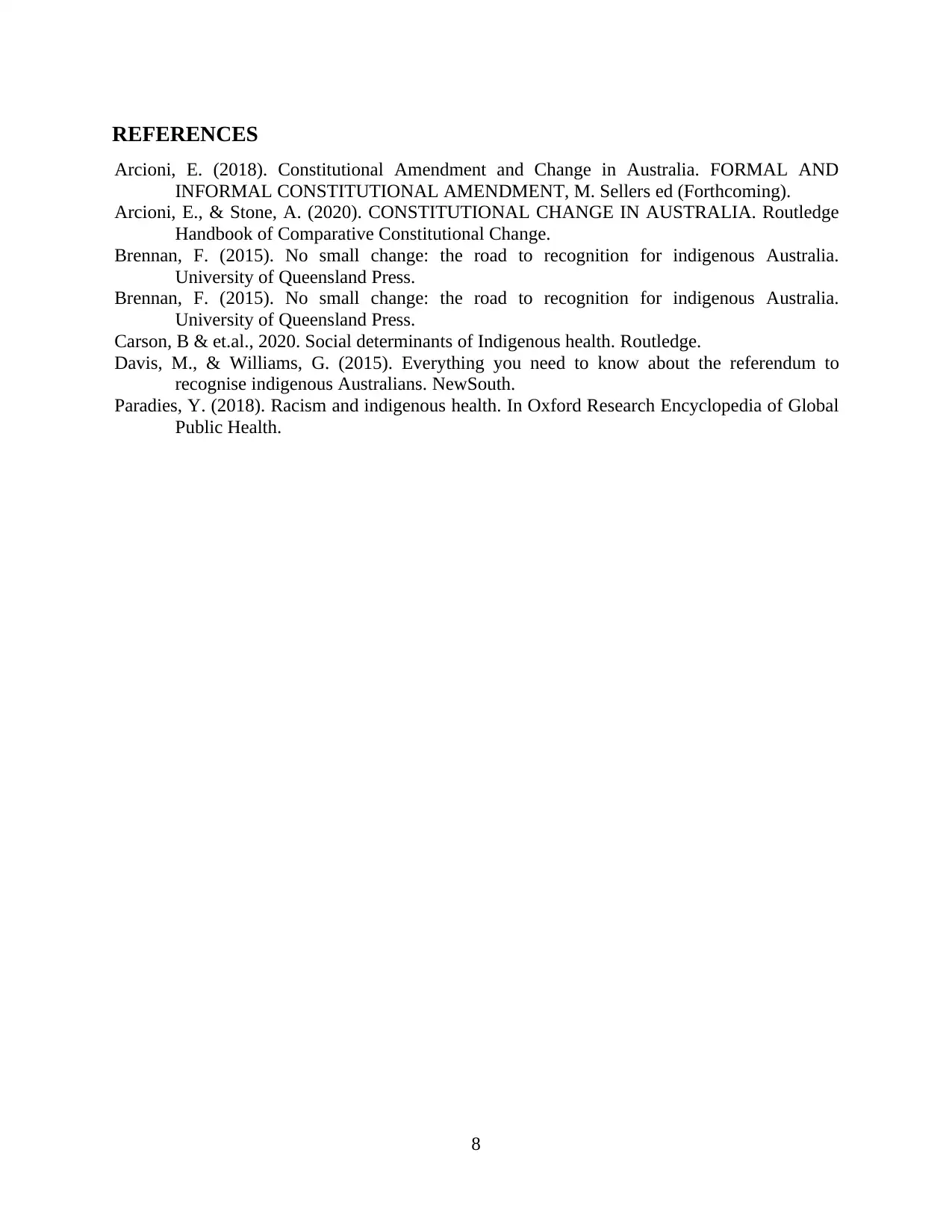
REFERENCES
Arcioni, E. (2018). Constitutional Amendment and Change in Australia. FORMAL AND
INFORMAL CONSTITUTIONAL AMENDMENT, M. Sellers ed (Forthcoming).
Arcioni, E., & Stone, A. (2020). CONSTITUTIONAL CHANGE IN AUSTRALIA. Routledge
Handbook of Comparative Constitutional Change.
Brennan, F. (2015). No small change: the road to recognition for indigenous Australia.
University of Queensland Press.
Brennan, F. (2015). No small change: the road to recognition for indigenous Australia.
University of Queensland Press.
Carson, B & et.al., 2020. Social determinants of Indigenous health. Routledge.
Davis, M., & Williams, G. (2015). Everything you need to know about the referendum to
recognise indigenous Australians. NewSouth.
Paradies, Y. (2018). Racism and indigenous health. In Oxford Research Encyclopedia of Global
Public Health.
8
Arcioni, E. (2018). Constitutional Amendment and Change in Australia. FORMAL AND
INFORMAL CONSTITUTIONAL AMENDMENT, M. Sellers ed (Forthcoming).
Arcioni, E., & Stone, A. (2020). CONSTITUTIONAL CHANGE IN AUSTRALIA. Routledge
Handbook of Comparative Constitutional Change.
Brennan, F. (2015). No small change: the road to recognition for indigenous Australia.
University of Queensland Press.
Brennan, F. (2015). No small change: the road to recognition for indigenous Australia.
University of Queensland Press.
Carson, B & et.al., 2020. Social determinants of Indigenous health. Routledge.
Davis, M., & Williams, G. (2015). Everything you need to know about the referendum to
recognise indigenous Australians. NewSouth.
Paradies, Y. (2018). Racism and indigenous health. In Oxford Research Encyclopedia of Global
Public Health.
8
1 out of 8
Related Documents
Your All-in-One AI-Powered Toolkit for Academic Success.
+13062052269
info@desklib.com
Available 24*7 on WhatsApp / Email
![[object Object]](/_next/static/media/star-bottom.7253800d.svg)
Unlock your academic potential
© 2024 | Zucol Services PVT LTD | All rights reserved.





